As an Amazon Associate I earn from qualifying purchases.
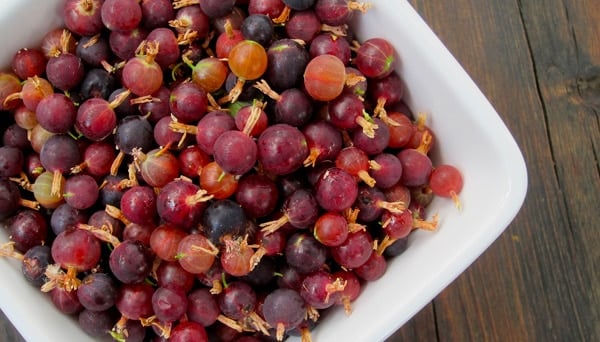
Ah, the gooseberry, an unloved berry if there ever was one — especially here in North America. We have nearly 100 varieties here, yet few people here even know they exist, let alone take to the woods in search of these beauties. Well, they do exist, and they are well worth your effort to hunt them up. Here’s what you need to know to gather ye gooseberries in style.
First you must find them.
Fortunately they grow pretty much everywhere on our continent, other than deserts… and there are even a few species that do thrive in arid regions. But in general, look for hills and mountains, cool(ish) climates and moisture.
When you are in such a region, look for spiky shrubs: A hallmark of the gooseberry clan is that they almost always have thorns all over them, on the branches and even sometimes the berries themselves.
Then there is the leaf. The maple-like leaves of gooseberries and their cousins the currants are very similar across all species. Memorize the shape of this leaf and you will start seeing it everywhere.

All currants and gooseberries have leaves that pretty much look like this.
How to tell the difference between a currant and a gooseberry? The fruits of both are edible, although there are more species of currant with an unpleasant, mealy or tannic flavor than there are of gooseberries, which are universally tart and a little sweet. Gooseberries set flowers and fruit in a line underneath the branches. Currants flower and fruit in clusters at the end of branches. Here are the flowers:

And here are the unripe fruits of the Sierra gooseberry:
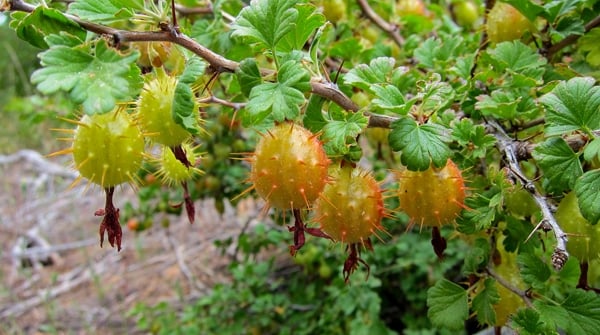
See the little “tail” on the bottom of the fruit? That’s the remnant of the flower, and it is another hallmark of the Ribes clan, which includes both currants and gooseberries. That little tail is perfectly edible, but you might want to remove it for fancy preparations.
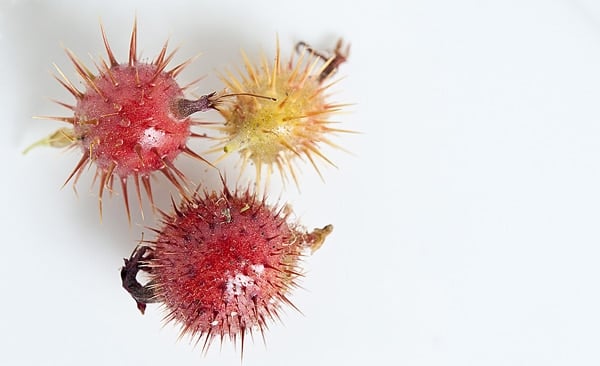
Now by now you might have noticed that wild gooseberries — especially these Sierra gooseberries above — are not the friendliest of fruits. I mean look at them! Nasty, spiky, prickly things that will impale your hands without a second thought. You must pick them with gloves or suffer the consequences. At least the Rocky Mountain wild gooseberry pictured at the top of this post not quite so prickly.
Most of the gooseberries east of the Great Basin can be eaten off the bush, although they are very tart. But the Sierra gooseberry and its prickly cousin that lives along the Pacific Coast is a bit more challenging. Bottom line is you need to cook these. Cooking softens the spines and lets you get at the delicious pulp within, which tastes brightly acidic and a little sweet. The aroma is weirdly similar to like Sweet Tarts candy.

The best way I’ve found to eat the prickly wild gooseberries is to cook them with a little water, smash the berries and strain the resulting pulp. The juice makes an excellent sorbet or syrup to use in cold drinks. It will also make a wonderful jelly. The pulp left behind can, it is said, be used as a pie filling, although I’ve never done that.
If your gooseberries don’t look like little Sputnik satellites, you can just eat them.
Since they are so tart, I love them with some sugar or honey and something dairy. My favorite way to eat them is to stir together mascarpone cheese with dark wildflower honey until combined, then fold in the gooseberries. Damn good.
Here’s how to process the spiky kind:
Gooseberry Syrup
Ingredients
- 8 cups Sierra gooseberries, or 5 cups smaller gooseberries
- Enough water to cover, about 1 quart
- 3 cups sugar or honey
Instructions
- Wash your berries well and put the Sierra gooseberries into a large pot. This seems like a lot, but they are large and very spiky, so they take up more space than other gooseberries. If you have regular gooseberries -- wild or domestic -- only use 5 to 6 cups. Barely cover the berries with water, cover the pot and bring to a boil.
- Boil for 2 to 3 minutes. Turn off the heat and, using a potato masher, crush the berries to a pulp. Do not use a blender, food processor or immersion blender! If you do, you will merely make the nasty spikes smaller and harder to remove later.
- Let this steep, covered, until it gets to room temperature, then pour everything through a fine-meshed strainer into a container and let it sit overnight in the fridge. The sediment at the bottom will be tan, the juice varying degrees of red or purple -- if you are using ripe gooseberries.
- Strain again through a fine-meshed strainer with a piece of paper towel set inside. This will leave you with clear juice. This juice will store in the fridge for a week or so, as-is. Or you can heat the gooseberry juice with an equal volume of sugar and make gooseberry syrup. The syrup lasts months in the fridge. As for the sediment, taste it. If it is not too gritty, you can mix it with a thickener like tapioca and make it into a pie filling.
Notes
Nutrition
Nutrition information is automatically calculated, so should only be used as an approximation.

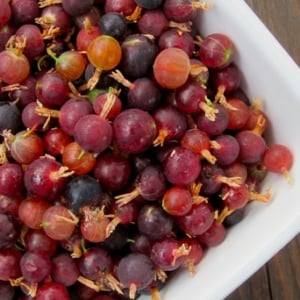




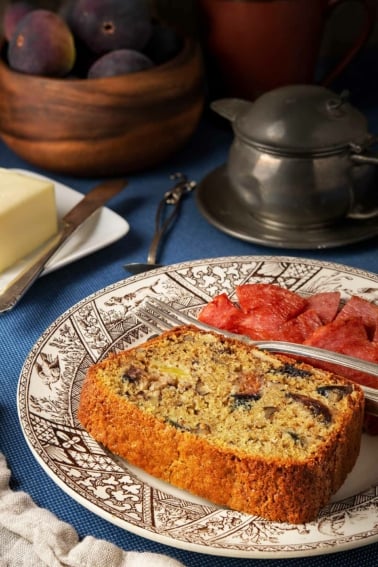
Thank you for what you do and for what you share. Now I know that these bushes that keep popping up all over my yards are producing edible berries; plan to make gooseberry syrup. Luckily, here in Wyoming, I have the Rocky Mt. strain; no spikes! Thank you so much for what you do and for what you share.
Hi. I have gathered the spiky gooseberries in the s Sierra mountains of California my question is I want to make jelly. But was wondering about altitude 6000 feet. Will it set?
Sue: Alas, I am not an expert jelly maker. So you’ll have to search elsewhere for making it at altitude. I’m sorry.
I’ve used this recipe a couple of times to make syrup and jelly with fantastic results! You mention using a thickener to turn the leftover pulp into a pie filling. Any chance you have a recipe? I’m not much of a baker and need some extra help. Thanks in advance!
How many times have a found myself on your site by trying to identify a SOCAL native plant that was new to me? Thank you for all of the human lore that you have so readily and freely shared—you have positively impacted our lives!!!
Found a small bush of non-spikey berries (very spikey brambles) in our local park in WI. The local wildlife doesn’t seem to eat them, so I’ll pick ’em and try one of these recipes. They’re good right off the bush, though, too!
Thanks for the info.
Grandson and I just picked
2 gallon baggies full of gooseberries from mountains of Colorado. They have tiny Sputnik hairs that catch the morning dew and when sun hits them it’s beautiful! The hairs are soft so no danger of getting spines but OH the thorns on the stems hurt! Can I use this same syrup recipe for them?
Cynthia: Yes, you can use them for this.
Thanks Hank for another great recipe! I made the syrup from some Missouri and prickly gooseberries I found in MN. Excellent!
We used to eat Sierra Gooseberries off the bush when we went camping in northern California. I remember selecting redish gooseberries with spines that were soft enough. We would smooth down the spines between thumb and fingers until we could carefully bite it with only our teeth. This would cause the fruit to burst open and then we would use our thumb and fingers to squeeze out the seedy jelly into our mouths. Delicious.
Hello love your site, what are the berries in the first photo?
they look identical to the ones I have but there are no thorns on the Bush and it grows large and fast!
thanks John
John: Those are gooseberries from the Rocky Mountains.
When it comes to the Sierra variety when I was a kid I would just peel the spines off and eat them. They have a similar taste to a kiwifruit when they are raw they are so good but it is a bit of work to get the spines off. Still worth it to try them raw.
Just discovered this website while looking for an easier way to prepare gooseberries for pies. I’ve been making fresh gooseberry pies for over 40 years, and hate the amount of time I have to devote to removing the stems and flower “tails”. Is there an easier way than doing this by hand?
Also, I was so surprised by the spiney-looking berries. Here in Missouri, they are smooth. We pick them while green, but not too small. By the time they turn red, they’ve lost the tartness and are more bland.
So,if anyone has a better, more efficient way to prep the berries, I’d love to hear about it.
Also, if anyone needs a pie recipe, I have two; one that is a bit juicy, and the other which I concocted using a custard-style base.
Thanks for any help.
Hi, just discovered a Rocky Mt gooseberry bush not far from my house and picked it pretty much clean to make some jam. I wondered about the little ‘tails’ so googled it and wound up here. Your pie recipe sounds intriguing! Not sure I have enough for anything but a couple of folded tarts (my pie plates are all too large) but I would love to know your recipe if you are willing to share it!
Thanks and happy foraging,
Francine
Hi.. I just came across many ripe red, like in the picture, currants/gooseberries with their tails on, in the eastern sierras above 8000 ft. Decided to make jam. Ha! They would not get soft even after 20 minutes of cooking!!! So I made some syrup, and the remaining spheres I added sugar, cooked them, ground them up in a grinder and canned them. The “jam” is a bit chewy and coarse but edible and interesting with a very unique flavor. Enjoyable.
I just made this for the first time, because gooseberries were my only successful take after a failed first mountain-quail hunt… converted it to syrup- definitely a recipe for the recipe box (Hoping for a jam recipe soon…)!!
I live at about 6500 feet near South Lake Tahoe, and we have another plant up here that seems to be larger, woodier, and overall lacking thorns/spines as a plant/fruit… but has the dangling flower and fruit characteristic of currant, and otherwise LOOKS like a gooseberry/currant bush… does this sound familiar to you as something forage-able? Thanks in advance!
Chadwick: It is likely a red currant. Edible, but boring. There are many gooseberries and currants in the Sierra!
Well, I read after IDing a patch near my house. I picked using leather gloves. I put 8 cups of berries in a pot with 1 qt of water, boiled and mashed with a potato masher when cool. Using a glass pitcher, I put a nut milk (i.e. jelly) bag inside, and squeezed all the juice out of the gooseberries, filtering it again through a sieve lined with another such bag into a large pickle jar.
Using a recipe from “Jams and Jellies from Native Wild Fruits” (https://www.ag.ndsu.edu/publications/food-nutrition/jams-and-jellies-from-native-wild-fruits) I put 5 1/2 cup of juice to boil with the equivalent of 1 pkg pectin (I threw in a few slices of ginger which I removed). After it came to a boil, I added 7 cups sugar (less next time) brought to back to a rolling boil and canned 8 half pints, using the water bath method. The resultant jelly is a lovely pink color, has no prickles, and tastes lightly of roses.
Thanks for sharing the jams & jellies site! I love jam so will try and make that, if it fails as some have said, then jelly it is!
Thank you for your post! We just picked several cups of wild, spiny gooseberries right in the woods behind our house in south central Michigan! We also grow cultivated gooseberries that are a bit more user friendly, but there’s something about discovering and foraging something you didn’t have to work for at all ? Do you know if you can make jam/jelly with wild gooseberries?
M.E.: Yes you can make jams and jellies from gooseberries.
“Sputnik Satellites” is most accurate and amusing. I found these growing along Highway 88 and plan to go back and try to pick some to see if I can use them in a recipe. Thanks for sharing.
Must I top and tail my gooseberries before making the juice?
Linda: Not if you are making juice, no.